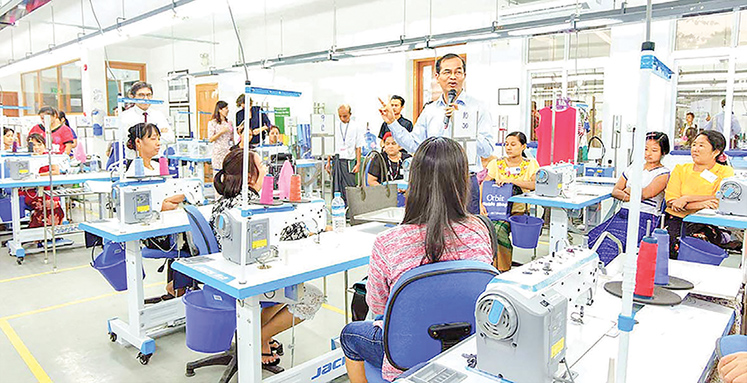By Shin Naw
Either we go to various regions and states of Myanmar or we come to Yangon from other parts of the country, industrial zones are a common sight on the outskirts of Yangon. Once these places grew under the influence of quietness, but nowadays they come alive with industrial images.
With a total of 29 industrial zones located on the outskirts of Yangon, nearby streets are swarming with factory workers during the rush hours. Garment is the largest among the industries in Yangon.
There are 389 CMP and CMP related factories in Myanmar until November in 2019. There are 338 garment factories with 214,895 workers employed.
According to the first-time survey of strength of workers conducted from February to April in 2018, more than 90 per cent of migrant workers are women migrant workers coming to urban areas from rural ones. Most of them don’t have good contacts with networks capable of offering assistance.
Those who lack occupational experience have become difficult in getting jobs following an increase in basic lowest salary. To exploit them becomes an easy job.
Aung Myin Hmu Project is offering livelihood programmes and support services to women migrant workers in order to go into a proper and secure profession in Yangon. Aung Myin Hmu is a consortium formed by Business Kind Myanmar and CARE International in Myanmar. Aung Myin Hmu is providing services with the help of Legal Clinic Myanmar.
With the financial assistance from Livelihood and Food Security Trust Funds, Aung Myin Hmu Project is working in partnership with the Ministry of Labour Employment, Immigration and Population, private organizations and CSOs.
Ma Hnin Phyu Phyu Aung, a manager of Aung Myin Hmu of Aung Myin Hmu Training Centre, said, “Our training centre is offering sewing courses for those hunting for jobs and migrant workers. At the end of the course, it will connect the trained workers to the employment. Aung Myin Hmu is providing courses such as sewing machine operator, quality control, cutting, spreading, mechanic, finishing/ironing and CAD/CAM. We teach the trainees technical knowledge, relationship, salary management, labour contract.
There are differences before and after trainings. Those who have attended the trainings dare to speak something and they are not ashamed of themselves. They are ready to go into a worksite as they make practices.
In the past, they did not know where to get work in the factory and how to apply for a job when they left their rural areas. They are poised to face either a worksite or an interview after attending our courses because they make practice in the basic training.
Our trainees can operate many types of machines. Our trainees can control up to five or six machines at a time when the workers can operate three to four machines in other worksites. Anyone either from Yangon or other regions and states can attend our training centre.
The one who is going to attend our training centre must be 18 years old. We mainly choose those who want to work in the garment sector. Our training is free of charge. One training will run for 40 days during which technical knowledge are provided. When the course finishes, we connect trained workers to factories.
Aung Myin Hmu’s courses mainly focus on technical know-how intended for the workers to go into a worksite quickly. These courses are aimed not only at providing employment to those who are in search of jobs but also at fulfilling the requirement of skilled workers.
Aung Myin Hmu serves a bridge between the employers and those who want to work.”
Senior Manager Ko Sai Thet Aung of Bogart Lingerie (Yangon) Factory said, “Our factory started in 2012 and it began operating in 2013.
In the past, we provided training, but we don’t have curriculum. Only operators were trained by machines.
We found a little difficulty in manufacturing. We have no time to draw up curriculum and it is not easy to draw up curriculum. When we meet Aung Myin Hmu, it prioritizes practice and training. It has curriculum.
Later, we established the training centre in partnership with Aung Myin Hmu. A total of nearly 20 batches have been concluded so far.
Ma Thin Thin Moe from Shwedaung, Pyay District in Bago Region, who is working in GDP garment factory in South Dagon, said, “Job opportunities are very rare in the countryside. The employment in the rural areas earns us a little.
I come to Yangon to hunt for a job of good pay. When I arrived in Yangon, I first worked for shoe factory because I was not able to operate sewing machine. I spotted Aung Myin Hmu Project through Facebook. I rang up Aung Myin Hmu Project and attended its training. I had to attend the training for about two months.
The lessons concerning labour law were taught in the afternoon. The training centre hunted for a job for me, but I went into a job after enquiries were made. I earn about K270,000 a month. Working hours are from 8 am to 8 pm.
Together with my friends, I am staying at a hostel exclusive of meals. Sometimes we buy meals and curry. Sometimes we cook meals and curry. Garment is one of the thriving industries in Myanmar and it is enormously growing in economic sector in Myanmar.
Export is on the increase. Garment workers are expected to increase from 400,000 to 1.5 million between 2014 and 2024. Garment export volume increased by 28 per cent in 2017, with a profit of over US$2 billion.
But later development became slower.
However, thousands of women from the rural areas are migrating to Yangon to work in the garment sector.
Translated by Htut Htut (Twantay)



